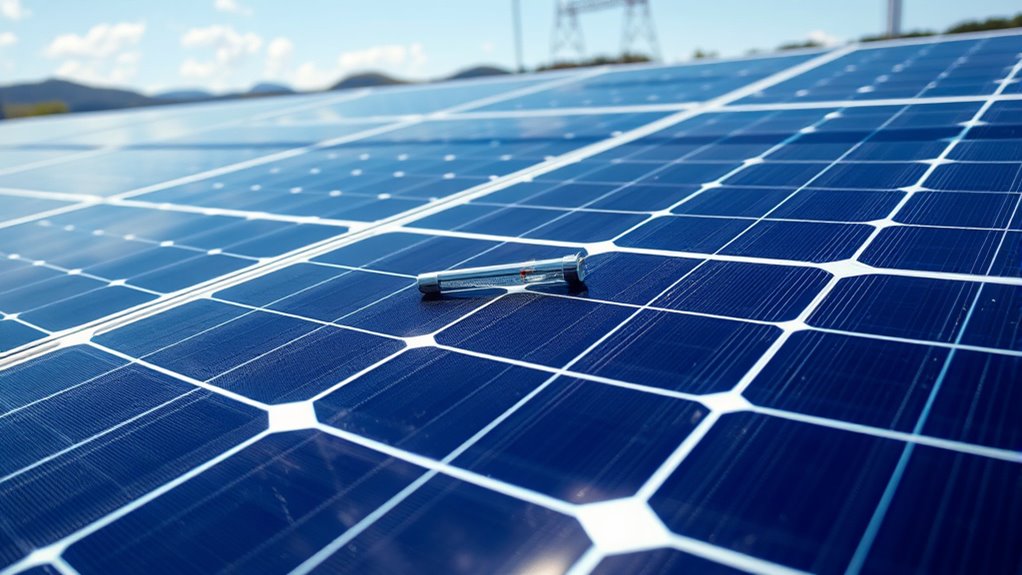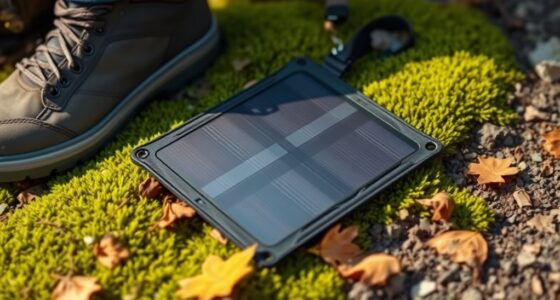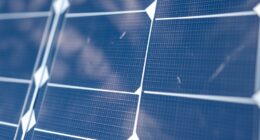Understanding solar panel temperature coefficients is crucial because they show how much your system’s power output drops as temperatures rise. Panels with better coefficients lose less efficiency on hot days, ensuring you get the most energy even in warm weather. Choosing panels with favorable coefficients or managing temperature can boost your system’s performance. Keep exploring to learn more about how optimizing temperature impacts your solar energy production and how to make wise choices.
Key Takeaways
- Temperature coefficients indicate how much solar panel efficiency drops as temperatures increase.
- Panels with lower temperature coefficients perform better in hot climates, maintaining higher energy output.
- Understanding these coefficients helps predict system productivity during peak sunlight and heat.
- Monitoring temperature effects allows for system optimization and informed panel selection.
- Choosing vetted panels with favorable temperature coefficients ensures reliable performance and reduces efficiency losses.

Understanding solar panel temperature coefficients is essential because they directly affect your panel’s efficiency. These coefficients indicate how much a solar panel’s power output decreases as the temperature increases, making them a critical factor to consider when evaluating performance. The efficiency impact becomes especially noticeable on hot days when elevated temperatures can markedly reduce the energy your panels generate. Recognizing this relationship helps you better predict your system’s productivity and optimize placement to maximize output.
Temperature measurement plays a crucial role in understanding how your panels will behave under different conditions. Accurate temperature readings allow you to assess how much your panels might lose efficiency during peak sunlight hours. Typically, manufacturers provide a temperature coefficient value, often expressed as a percentage decline per degree Celsius above 25°C (77°F). For example, a coefficient of -0.35%/°C suggests that for every degree your panel’s temperature exceeds 25°C, its power output drops by 0.35%. This information helps you anticipate performance drops during hot weather and plan accordingly.
Knowing the efficiency impact of temperature coefficients encourages you to choose panels with lower values when possible. Panels with more favorable coefficients tend to perform better in high-temperature environments, maintaining higher energy production levels. This can be particularly beneficial if you live in a region with intense sunlight and warm temperatures year-round. Proper temperature measurement, whether through built-in sensors or external tools, ensures you can monitor real-time conditions and understand how they influence your system’s output. Regularly tracking temperature data helps you identify patterns and adjust your system for maximum performance.
Furthermore, understanding these coefficients isn’t just about avoiding losses; it’s about making informed decisions. For example, if you know your panels tend to lose efficiency when temperatures rise, you might consider installation strategies like shading or ventilation to keep them cooler. Using a monitoring system that tracks temperature alongside energy production allows you to see firsthand how temperature fluctuations impact your panels. This insight can guide future upgrades or modifications to enhance overall efficiency.
Being aware of vetted products and their performance characteristics, including temperature coefficients, helps you select the most reliable and efficient solar panels for your specific climate.
Frequently Asked Questions
How Do Temperature Coefficients Compare Across Different Solar Panel Brands?
You’ll find that temperature coefficients vary across different solar panel brands, impacting efficiency differences. Generally, premium brands tend to have lower (more favorable) temperature coefficients, meaning they perform better in hot conditions. When comparing brands, look at their temperature coefficients to understand how much efficiency drops as temperatures rise. This helps you choose panels that stay efficient in your climate, ensuring you get maximum energy output over time.
Can Temperature Coefficients Change Over a Panel’s Lifespan?
A stitch in time saves nine, and that applies here too. Temperature coefficients can change over a panel’s lifespan due to degradation patterns, leading to efficiency shifts. As your solar panels age, their ability to handle heat may decline, slightly altering their temperature coefficients. This means their performance might not be as predictable as when new. Regular inspections and monitoring help you stay ahead of these changes, ensuring ideal energy output.
Do All Panel Types Have Similar Temperature Coefficients?
Not all panel types have similar temperature coefficients; material differences and manufacturing variability cause variations. For example, monocrystalline panels typically have lower temperature coefficients than polycrystalline ones, meaning they perform better in hot conditions. You’ll notice that the manufacturing process affects these coefficients too, so even panels of the same type can differ slightly. Understanding these differences helps you select panels that perform efficiently in your climate.
How Do Outdoor Conditions Affect Temperature Coefficient Performance?
Did you know that outdoor conditions can cause solar panel temperatures to rise by over 50°C? This environmental impact markedly affects their temperature coefficient performance, leading to decreased efficiency. Hotter weather stresses the panels and can reduce durability over time. So, when you choose panels, consider how outdoor conditions might influence their performance and lifespan, ensuring you get the most from your investment in solar energy.
Are There Ways to Mitigate Negative Effects of High Temperatures?
You can mitigate high-temperature effects by implementing cooling techniques like passive cooling, such as using reflective coatings or heat sinks, and active systems like water spray or fans. Ventilation solutions also help by increasing airflow around your panels, preventing overheating. These methods reduce temperature stress, maintain efficiency, and prolong your solar panel’s lifespan, ensuring you get the most energy output even during hot days.
Conclusion
Understanding solar panel temperature coefficients helps you choose the right panels for efficiency and longevity. Remember, a smart investment today can save you money tomorrow. Don’t put all your eggs in one basket; compare different panels to find the best fit for your climate. By considering temperature effects, you guarantee your solar system performs at its best year-round. As the saying goes, “Knowledge is power”—and in solar energy, it truly makes a difference.









